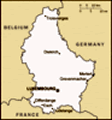Advertisement
Published: March 4th 2011

 Place Guillaume II
Place Guillaume II
Food and flower marketsWednesday 2 March 2011
Another cloudless but cold and misty day, with a strong biting wind - the locals tell us we're lucky to be getting this sort of weather (we're not complaining).
We headed off to Luxembourg City today in our little hire car. Thank gods for the GPS - it got us right to the carpark we wanted without a hitch. We shouldn't be too surprised as it's a fairly small city, housing around 88,000 people (about 20%!o(MISSING)f the total population). Making a bee-line for Place Guillaume II (the main city square) we found it jam packed with a food and flower market. We didn't buy anything, but we did drool a bit!
Luxembourg is a pleasant city to walk around; it's light and airy, as is its cathedral (Notre Dame). Ali was very impressed with the tapestries hanging in the cathedral - haven't seen that before. As we've found in many of the European cities and towns we've visited, the atmosphere is enhanced by the church bells ringing out their melodic tunes every quarter hour or so.
One really poignant spot is the war memorial in Constitution Square. Here there are two statues, one
of a soldier mourning a fallen comrade and the other a huge column topped with a 'gold' statue of Nike (god of victory). Erected after WWI, it was knocked down by the Nazis (in an attempt to demoralise the locals) when they occupied Luxembourg in WWII. However, this only served to strengthen the resolve of the proud Luxembourgers to resist their occupiers. It was only recently (1980s?) that the statue of Nike was recovered and restored to the top of the pillar.
Luxembourg straddles a huge ravine (carved by the Alzette River), along which the most amazing ramparts were built in the 17th century. We walked along the top of these to the site of Count Siegfried's castle (built in the 10th century, destroyed between 1867 and 1883). The ramparts defended the city very well during the French Revolutionary wars, however it eventually fell after a 7 month siege. Beneath the ramparts are what are known as the "Bock Casemates" - a honeycomb of rock galleries and passages, carved out in the 18th century. They've been used for everything from bakeries to slaughterhouses and although they've been partly sealed, there remains about 17km of tunnels! During the WWII bombardments,
around 35,000 people took shelter in these tunnels.
Below the ramparts and hugging the river, is a small area called "The Grund". Almost like a village within the city, it's full of cafes, bars and museums as well a large abbey. It was really quiet when we were there and we had trouble finding a cafe that was open (well, there was one where the entrees were around 52 Euros, so we thought we'd keep looking - Luxembourg is quite a wealthy country!). After finding a very reasonably priced cafe and filling up on strudel, we wandered back along the river, through some lovely parklands and climbed the steep stairs back to where we started.
Wandering back past the Palais Grand Ducal (the Duke no longer lives there, but uses it as an office - along with many public servants) we noticed a lot of activity around the entrance: extra guards marching up and down and a small group on onlookers (cameras at the ready). We decided to loiter and see what was going on. A heap of police motorbikes whizzed past followed by a couple of black cars in which were sitting very important-looking personages in their
fancy uniforms. A few minutes later, another lot of important-looking people came out and sped off - that was it! The Luxembourgers are apparently very enamoured of their royal family. Prior to 1890, the Dutch King was also the Duke of Luxembourg. When he died and his daughter Wilhelmina took the throne, the succession laws of Luxembourg did not allow for a female monarch. Thus, their previous nominal independence became a reality and Adolph Nassau became Grand Duke. His descendants rule to this day. In 1907, changes to the hereditary laws allowed Marie Adelaide to become Grand Duchess, but perceptions of her pro-German stance during WWI led to her abdication after the war. Amazingly, the Grand Duchy put its royal family up for referendum in 1919! The country voted resoundingly in support of the royals, and Marie Adelaide's sister, Charlotte took the throne. Their continued popularity is probably due in part to their apparent 'normality' - the children all attend normal schools and the royals can be seen wandering around the shops alongside everyone else.
We drove home via Larochette - yet another picturesque village topped by a castle on a rocky crag! It was getting quite dark, but
we hastily ran around 'rubber-necking' (in the freezing cold) and taking a few photos.
Advertisement
Tot: 0.077s; Tpl: 0.012s; cc: 8; qc: 31; dbt: 0.0304s; 1; m:domysql w:travelblog (10.17.0.13); sld: 1;
; mem: 1.1mb













